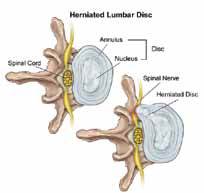How are your discs?
In the United States, 80 percent of the population will experience low back pain sometime in their lifetime. One of the most common areas of repetitive trauma that leads to pain and dysfunction is the intervertebral disc.
There are 33 vertebral bones in the total spine with a total of 25 moving segments. Situated between each vertebra is the intervertebral disc. The integral effort of the joints and discs with the support of muscles, joint capsules and ligaments work together to allow for mobility but to limit with stability. This effort allows each of us to functionally use our spines throughout the day.
The vertebrae provide a structural framework and depending upon the angle, are afflicted with compressive loads. Body weight is transmitted across this framework. It is now thought that a healthy disc can withstand more pressure than the vertebra. When healthy, the bone actually acts as a shock absorber, the disc acts more like a ball bearing as it tries to equally distribute the stresses that are applied to it over the whole segment.
The intervertebral disc has two components. First is the annulus. It is comprised of layers of collagen tissue that is very resilient. The healthy annulus can deform somewhat to permit movements yet check excessive motions by attaching firmly to the vertebrae above and below. It acts to stabilize the spine and check excessive motions. This annulus is a stabilizer and contains the nucleus, the inner portion of the disc. The healthy nucleus can deform as does not change its amount of fluid volume. It is contained by the annulus and its ball bearing properties help to disperse any loads applied to the spine.
The annular fibers are challenged with rotational motions. If excessive strains are applied to this portion of the disc, small annular tears can occur. Cumulatively, these tears become weakness and now the job of the annulus containing the nucleus can become compromised. Naturally, the body innately moves from a high-pressure zone lower pressure (the path of least resistance). If the spine continues to be challenged, the ball bearing capacity of the nucleus deforming within the contained annulus is limiting and the nucleus can move towards the weaker annular tissue. The load bearing and stability of the segment is thus limiting. The nucleus can actually bulge out and herniate. 
Approximately 52 percent of asymptomatic people already have at least one bulging disc. Over time repetitive poor body mechanics, poor form in sports, excessive twisting at a specific spinal may eventually lead to localized pain, muscle guarding, or neurological symptoms such as leg pain, numbness and tingling and in the worse case scenario, weakness occurs.
When a person gets back pain there are a lot of assumptions made of what may be causing the pain yet the actual initial injury could have been years prior. Now many people start telling you that they have back trouble and they tell you what they do to help themselves (if they do anything). The problem is no two back injuries are identical and you most certainly do not want to do things that can hurt you further and cause progression of a disc injury.
So what should you do to protect your back if you do have disc issues? First, never force motion in the spine. If there is pain, STOP . If there is a tear in the annulus, it is usually posterior or posterior lateral so use caution. Initially, stretching is not good for this problem and can cause further problems. First, think of this sick disc like a cut: You do not stretch a cut; allow the cut to stabilize to allow for healing. Discs do not heal well so they depend on some scarring to help to stabilize the area. If there are leg symptoms the goal is to get rid of the leg pain by gentle movements and positioning. Sometimes small backward bending motions that do NOT cause any pain can be done but not forced. If there are minimal disc issues, this may help the disc and help to neutralize it in attempts to calm the symptoms. If this motion causes increased symptoms of any kind, stop. Some experts say that an acute disc injury should not be opened or stretched for at least two weeks. This is a good rule to follow for precaution but most people once feeling better do not have the patience to wait.
Repetitive motions, rotations on a sick disc, and poor mechanics will certainly lead to further injury of the disc. The rule of thumb is to control motions, avoid overstretching a disc, learn about body mechanics and adapt your physical activities as needed to avoid excessive stresses to the discs and learn about the basics of proper postures (sitting, lying, lifting).
Core strengthening with proper stabilization and positioning is key. Remember that no two backs are alike so you need specific strengthening and stretching designed specifically for you! Sweat the small stuff when it comes to your back. You will find that you can ontinue to participate in most activities if you make your back last. EVERYBODY can improve. Start now to give your bones and discs the proper care to live a more productive life everyday. There is always something that you can do to help yourself. Don’t let yourself be a victim.
For further information please call Paula at Fitness Together in downtown Naples 239.263.9348 239.263.9348.
239.263.9348.


Leave a Reply
Want to join the discussion?Feel free to contribute!